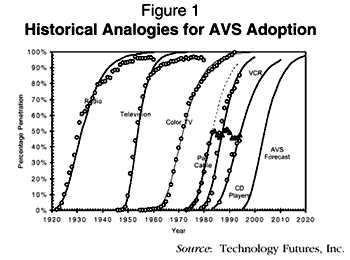
Looking forward, we see at least two more decades of rapid change driven by the increasing integration of three dynamic industries: television, computers, and telecommunications. This environment is leading us to recognize a new industry, or at least a newly-defined industry, that is as full of promise and uncertainty as television was 50 years ago.
The business of this new industry is advanced video services (AVS).1 AVS includes such services as video on demand (VOD), interactive entertainment and games, distance learning, home shopping, and telemedicine. The players in AVS include industries providing content, technology, and network services. Old-timers like broadcasters and cable operators are being joined by newcomers from the telephone, satellite, and computer industries. The potential impact of these new services -- and new service providers -- on how we do business, how we advertise, how we entertain ourselves, how we are entertained, and even how we conduct our personal communications is just beginning to be explored.
This article addresses one aspect of this new industry, namely, the patterns by which AVS will likely be made available by suppliers and be adopted by consumers. These forecasts are intended to help decision makers who are concerned with timing the development of the advanced video services market and the supporting infrastructure.
| Table 1: A Classification of Video Services by Customer Interface | |
|---|---|
| TV-Based | Computer-Based |
| Basic Cable Pay Cable (Premium Channels) Pay-per-View Near Video-on-Demand Video-on-Demand HDTV | Access to On-Line Services Access to Internet Videoconferencing Telecommuting |
| Interactive Games & Programs Transactional Services (Home Shopping, Banking) Distance Learning | |
| Source: Technology Futures, Inc. | |
Which services qualify as "advanced" is subject to some interpretation. For our purposes, we assume that advanced video services provide, at the least, some minimal level of interactivity, since this is the underlying theme of almost all advanced video services from games to video on demand. Interactivity implies some level of consumer choice. At the lowest level, "choice" will be confined to selection and timing of programs. Consumers will have the ability to select from a much greater range of traditional programming, and they will have greater control over the timing of the selected programs, than they do with current pay-per-view. With this definition, the services currently provided by direct broadcast satellite (DBS) broadcasters qualify, with up to 175 channels of programming including movies, sports, and special events.
Although, with this level of choice, television is still basically a broadcast medium, over time, broadcasting will begin to give way to narrowcasting. As the level of interactivity increases, "choice" will include the ability to have some measure of control of program content beyond selection and timing. For example, consumers might choose specific viewing angles of a sporting event. Assessing the appropriate level of interactivity, in terms of both consumer demand and the cost to provide such services, is a key competitive decision facing all providers of advanced video services.
Current DBS services fall somewhere between traditional pay-per-view and what many people call near video on demand (NVOD). With NVOD, popular movies begin on multiple channels at staggered start times. Video rental statistics indicate that most customers are primarily interested in the newest and most popular (say, top 20) movies. NVOD would make these movies available every 15 minutes or so; however, typical VCR functionalities such as pause, rewind, and fast forward would not be available. With the limitation on the number of movies and without VCR functionality, NVOD is a near, but not a perfect, substitute for video rentals.
True VOD is a service in which the customer has the ability to select and receive a wide range of video-based content on a nearly instantaneous basis. The customer has full, VCR-like control (pause, rewind, fast-forward, slow-motion) over the video stream. True VOD requires a channel dedicated to each customer, at least on a part-time basis.
Technologically, true VOD is a perfect substitute for the video store. As long as video rentals have priority in the video release sequence, VOD will have the same disadvantage that pay-per-view currently has. Apart from this issue, any cost differences, and any intrinsic social need to go to video stores (one that I personally don't share), VOD has the potential to replace the video store.
In the longer run, however, advanced video services are more than a glorified video store. As switched video permeates the communications networks and the distinctions between television and interactive multimedia blur, the narrowcasting we mentioned earlier will become a reality. This does not mean 500-channel television, but rather the ability to select, from tens of thousands of programs, the handful that interests you and your family. For example, the list for my household would include:
In the same timeframe that AVS begins to migrate to higher levels of interactivity -- the early 2000s -- another advanced video technology, digital high-definition television (HDTV), will emerge as an important force in video. With its enhanced resolution, all-digital format, wide aspect ratio (ideal for sports and movies), and compatibility with multimedia computers, HDTV will be attractive in both large screen and small screen packages.
Technologically, AVS implies digital compression in the transport mechanism and new set-top boxes at the customer location. As interactivity becomes a dominant factor for success, AVS will also imply digital video switching. At first, we expect the switching to be limited to the headend for the distribution of video services from a video server. Later, we expect national and international distribution through switched digital wide area networks. In either case, Asynchronous Transfer Mode (ATM) will likely emerge as the dominant switching technology. By the time HDTV advanced video services (HAVS) becomes important, we expect that AVS will reflect the advanced switched features. HAVS will add higher resolution, a wider aspect ratio, and increased compatibility with computers and multimedia services.
When measured as a percentage of all households, video and consumer electronics adoptions generally follow an S-shaped curve characterized by the Gompertz model (or similar models). In other words, the percentage of households that have adopted the technology rises slowly at first (though rapidly in terms of annual percentage growth), speeds up for a while, and then slows down again. The pattern is caused by a combination of factors including availability, cost, value, diffusion, mortality (of equipment, and, sometimes, people), and technology improvement. Generally, these factors balance out to yield the reasonably stable and predictable S-shaped curve, although the overall period for adoption varies among technologies.
Figure 1 shows the adoption curves for a series of consumer electronics and video adoptions, along with our forecasts for the adoption of AVS, which we assume begins at 1% of U.S. households (estimated DBS penetration) at year-end 1995 and then proceeds at a rate equal to the average of the other adoptions. The AVS forecast is shown by itself in Figure 2. The forecast implies that advanced video services will be found in 10% of U.S. households by the end of 2001 and in almost half of U.S. households by 2005.

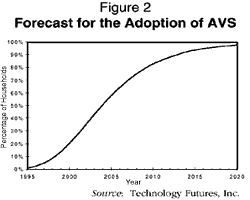
The forecast assumes that availability of terrestrial AVS services is not an immediate issue governing AVS adoption. NVOD, or at least "near" NVOD, is already available in the form of DBS to roughly half of all households. By the time interactivity becomes the determining factor for customer choice of AVS, there should also be significant terrestrial AVS availability. DBS will find it difficult -- if not impossible -- to reach the levels of interactivity possible in terrestrial systems. In other words, DBS may get the ball rolling with widespread availability of a limited form of AVS, but it will face increasingly tough competition as consumers are exposed to -- and demand -- higher levels of interactivity.2
Traditionally, video services have required significant infrastructure investment by suppliers, and thus the services have not become immediately available to all potential customers. In previous studies, we have found that when availability (the percentage of all households that are able to subscribe to the service) increases in a typical pattern, coincidentally, the percentage of all households (not just those with it available) adopting the service follows the Gompertz model. Availability (the percentage of all households that are able to subscribe to the service) typically follows the Fisher-Pry model. The Fisher-Pry model is characterized by a symmetric S-shaped curve when the percentage of households that can receive the service is plotted over time. The take rate (the percentage of households which can receive the service that actually subscribes) is simply subscribership divided by availability. It starts out anywhere between 10% and 50%, increases for a while, dips, and then increases again. Figure 3 illustrates this relationship for pay cable (subscribership levels off in this example because of competition from video stores).3
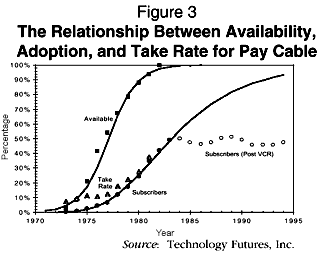
We use the relatively stable relationship between availability and adoption to determine the "ideal" Fisher-Pry curve for terrestrial AVS availability to match the "target" AVS Gompertz adoption curve we have already derived. If terrestrial AVS providers match this ideal curve, they should get their fair share of AVS customers. Otherwise, lacking an alternative, customers will adopt DBS.
It is already too late for potential terrestrial AVS providers to match this ideal availability curve since terrestrial availability today is nowhere near 3%. Thus, we propose an alternative terrestrial availability curve that reflects an attempt to "catch up" with the ideal curve. It assumes that terrestrial suppliers will reach 1% availability by year-end 1996 (on the basis of existing trials and announced services) and an extremely fast buildup of availability after that time, similar to that for pay cable in the 1970s and about as high as we have seen.
The forecasts for AVS adoption and ideal and projected terrestrial AVS availability are shown in Figure 4. We forecast that terrestrial availability for advanced video services will reach 10% by 1999 and 50% by 2001. The high rate of expected growth reflects the level of competition among terrestrial players (who gets there first captures the customer) and the necessity to get in the game before DBS has reached its full potential market. While interactivity may ultimately make terrestrial services more attractive than DBS, customers that have already invested in DBS equipment may be harder to convert.
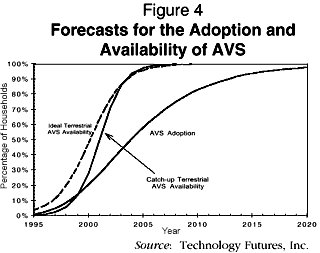
We posit that 1% penetration will be reached by year-end 2000. This assumes that the U.S. Federal Communications Commission (FCC) approves the proposed standards in 1996 and HDTV receivers enter the marketplace sometime in 1997 (which is consistent with announcements that have already been made). If typical patterns are followed, initial commercial broadcasting would begin in 1997 or 1998, with several more years required to penetrate the first 1% of the market. The roughly four years from standards adoption to 1% penetration is inconsistent with our historical analogy (color TV), which took nearly eight years to reach the 1% penetration point. However, we believe that the circumstances that surrounded early color TV adoption reflect constraints, such as the availability of programming, that will not apply to HDTV.
Although we felt the pre-1% experience with color television was not applicable to HDTV, we believe that, after 1% adoption, color TV provides a good analogy. As evident from Figure 1, color TV was one of the slower historical consumer adoptions. Figure 5 shows our forecast for HDTV adoption, with about one-half of U.S. households acquiring HDTV by 2010. Even in the years of most rapid HDTV adoption, only 7% of households would be upgrading to HDTV in any given year. This is about the level of normal replacements we would expect if a television lasted, on average, 14 years. Thus, our forecast does not imply that people will rush out immediately to replace their existing sets that are working fine. It does assume, however, that HDTV sets decline in price similar to color TV sets in the 1960s.
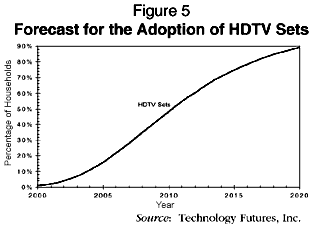
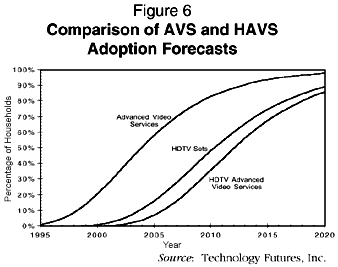
We forecast the terrestrial availability of HAVS by using the same relationship between adoption and availability that we did for AVS. The results for the HAVS availability forecast are shown in Figure 7. Terrestrial HDTV availability reaches the 10% and 50% thresholds in 2004 and 2008, respectively.
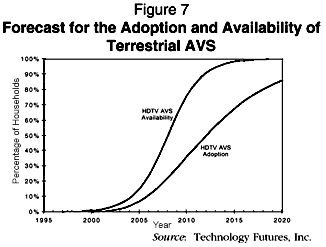
First, they imply that DBS will have a significant life, even if terrestrial service ultimately dominates. Thanks to the prescience and commitment of its pioneers, DBS simply has enough of a head start, with a good product, to stay in the game well beyond most people's planning horizons. Little wonder it is attracting the attention of players hoping to get into the action by marketing it. The long-term question for DBS is whether it can leverage its early market share and returns on investment, and keep up with the level of interactivity that is possible with terrestrial networks.
Second, terrestrial-based services will be hard-pressed to stay in the AVS game at all. They will have to make significant investments quickly to start service and evolve rapidly to higher levels of interactivity than DBS. Otherwise, they will be left with the customers that cannot receive DBS and are not content with standard broadcast offerings. With video stores, cable, telephone companies, and MMDS (wireless cable) fighting over the leftovers, it may get ugly.
Third, the migration to HDTV is within the planning horizon of companies making substantial infrastructure investments, which may be amortized over 10 to 20 years. It surprises me how little consideration terrestrial providers give to even the possibility of HDTV adoption when they lay out their plans for infrastructure rollout.
Finally, while there are certainly opportunities in conventional cable television and its evolution through pay-per-view, near video on demand, and video on demand, these services do not significantly increase the total revenue pie. New revenues that expand the total communications revenue pie will come from interactive digital services serving both computer-based multimedia and television-based applications. While these markets are not as certain or short-term as television, they are where the new opportunities lie -- information, commerce, communications between people, telemedicine, distance learning, and really exciting entertainment. The adoption of on-line services and the Internet, interactive multimedia, and AVS are all on roughly the same trajectory, implying significant wealth for those companies that can manage the synergies instead of getting caught in the crossfire. The well-deserved success of new television players such as DBS notwithstanding, the best is yet to come.